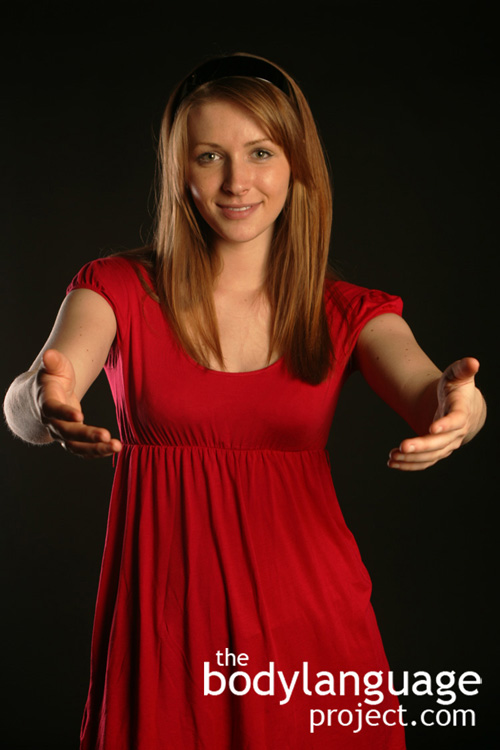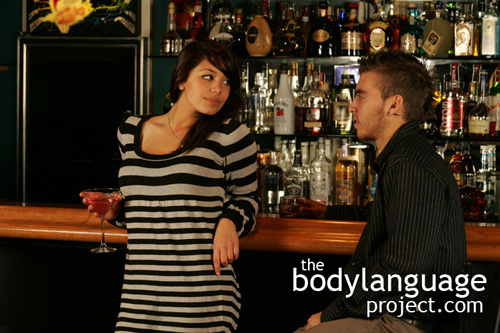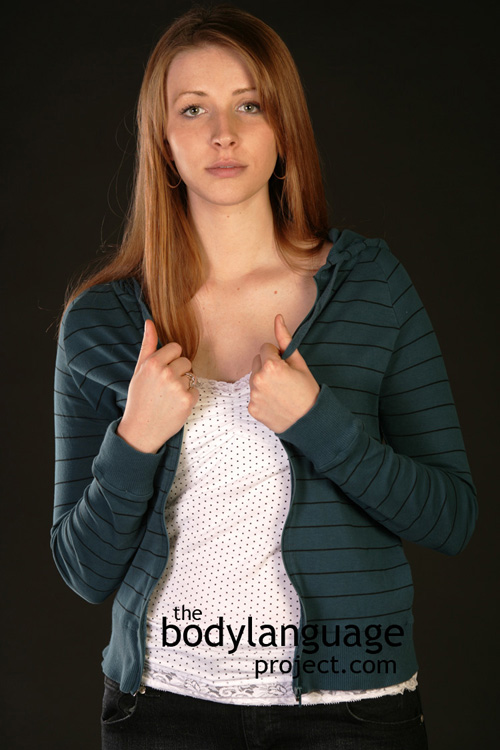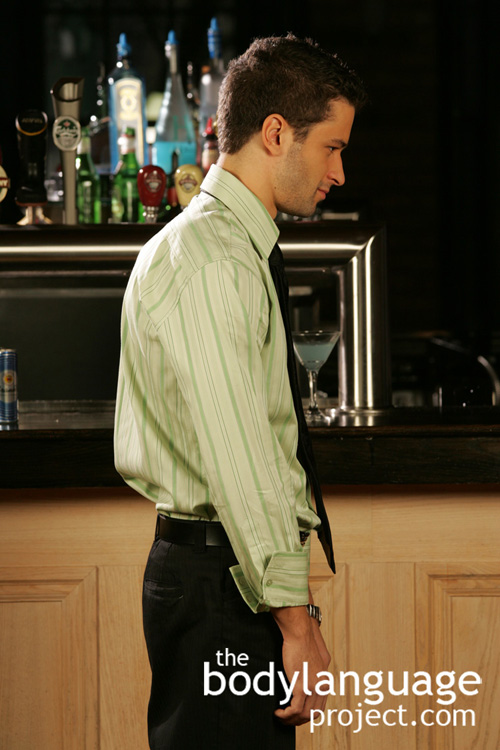Body Language of Arms Forward
 Cue: Arms Forward
Cue: Arms Forward
Synonym(s): Jesus Pose.
Description: A body position where the hands come forward in front of the body.
In One Sentence: Arms forward signals that attention is in the front of the body and one wishes to bring or repel that attention toward or away from themselves respectively.
How To Use it: Use the arms forward posture to welcome a crowd like a big embrace (the Jesus Pose). The hands may be used in an up and down motion to help emphasis elements in speech. The hands flipped upward can be used to show that one is offering and idea, turned down, to show that one is authoritative and fixed on a point of view, or turned palm out, to repel ideas or people. Therefore, it is the orientation of the palms coupled with the relative movement that dictates your use of the arms forward posture. The embodiment of the gesture is thought to activate certain emotions in people. Pulling toward or pushing away, for example, even without acting on an object, bring to consciousness relative cognitive perceptions. Thus, use your arms in unison with speech to create congruency between body and mind. People will see this as honesty and integrity.
Context: a) Business b) Courtship c) General
Verbal Translation: “Something at the front of my body requires attention”, “I’m drawing attention to myself.”
Variant: Hands might come forward fists clenched, palms up or down, in a chopping motion. See Baton Gesture, Arms Up Posture.
Cue In Action: a) When presenting at a conference, he raised his arms Jesus-like in front of him like a giant hug to accept the crowd’s adulation. b) She beckoned him to come toward her so she could give him a big hug by raising her arms in front. c) The teacher pushed her palm forward and yelled forcefully, “stop!” The students were getting too rough with one another.
Meaning and/or Motivation: Having the arms forward can mean that a person wishes to hug, to fight if fists are clenched, to repel (a physical attack, or likewise, their opinion) if the palms are facing vertical toward an opponent as if pushing away, begging, if palms are turned upward, and authoritative if palms are turned downward.
Cue Cluster: N/A
Body Language Category: Defensive, Threat displays, Expansive movements, Honest body language, Confident body language, Hostile body language, High confidence hand displays, Indicators of sexual interest (IOsI), Intention movements, Open body language.
Resources:
Alibali, M.W., Heath, D.C., and Myers,H.J. (2001). Effects of visibility between speaker and listener on gesture production: Some gestures are meant to be seen. Journal of Memory and Language, 44, 169–188.
Beattie, G., & Shovelton,H.(1999). Mapping the range of information contained in the iconich and gestures that accompany spontaneous speech. Journal of Language and social Psychology, 18, 438–462.
Biau, E., & Soto-Faraco, S.(2013). Beat gestures modulate auditory integration in speech perception. Brain and Language, 124(2), 143–152.
Bartolo, A.,Cubelli,R.,DellaSala,S.,&Drei,S.(2003).Pantomimes are special gestures which rely on working memory. Brain and Cognition, 53, 483–494.
Bernardis, P.,& Gentilucci,M.(2006).Speec hand gestures are the same communication system. Neuropsychologia, 44, 178–190.
Buccino, G.,Vogt,S., Ritzl, A., Fink, G .R., Zilles, K., Freund, H. J., et al.(2004).Neural circuits underlying imitation learning of hand actions: Anevent-related fMRI study. Neuron, 42, 323–334.
Cacioppo, J. T., Priester, J. R., & Berntson, G. G. (1993). Rudimentary determinants of attitudes: II. Arm flexion and extension have differential effects on attitudes. Journal of Personality and Social Psychology, 65, 5–17.
Cashdan, Elizabeth. Smiles, Speech, and Body Posture: How Women and Men Display Sociometric Status and Power. Journal of Nonverbal Behavior. 1998. 22(4): 209-228.
Fo¨rster, J. (2004). How body feedback influences consumer’s evaluation of products. Journal of Consumer Psychology, 14, 415–425.
Friedman, R. S., & Fo¨rster, J. (2000). The effects of approach and avoidance motor actions on the elements of creative insight. Journal of Personality and Social Psychology, 79, 477–492.
Friedman, R. S., & Förster, J. (2000). The effects of approach and avoidance motor actions on the elements of creative insight. Journal of Personality and Social Psychology, 79, 477–492.
Friedman, R. S., & Förster, J. (2002). The influence of approach and avoidance motor actions on creative cognition. Journal of Experimental Social Psychology, 38, 41–55.
Fabbri-Destro, M.,& Rizzolatti,G. (2008). Mirror neurons and mirror systems in monkeys and humans. Physiology, 23, 171–179.
Fogassi, L., Gallese,V., Fadiga,L., & Rizzolatti,G. (1998). Neurons responding to the sight of goal directed hand/armactions in the parietal area PF (7b) of the macaque monkey. Society for Neuroscience, 24, 257.5.
Fusaro, M., Harris, P. L., & Pan, B. A. (2012). Head nodding and head shaking gestures in children’s early communication. First Language, 32, 439–458. doi:10.1177/0142723711419326
Gentilucci, M., Bernardis, P., Crisi,G., & Dalla Volta, R. (2006). Repetitive transcranial magnetic stimulation of Broca’s area affects verbal responses to gesture observation. Journal of Cognitive Neuroscience, 18, 1059–1074.
Goldin-Meadow, S. (1999).The role of gesture in communication and thinking. Trends in Cognitive Sciences, 3, 419–429.
Goldin-Meadow, S.(2003). Hearing gesture: How our hands help us think. Cam-bridge, MA: Belknap Press of Harvard University Press.
Gräfenhain, M., Behne, T., Carpenter, M., & Tomasello, M. (2009). One-year-olds’ understanding of nonverbal gestures directed to a third person. Cognitive Development, 24, 23–33. doi:10.1016/j.cogdev.2008.10.001
Guidetti, M. (2005). Yes or no? How do young children combine gestures and words to agree and refuse. Journal of Child Language, 32, 911–924. doi:10.1017/S0305000905007038
Gorkan Ahmetoglu, Viren Swami. Do Women Prefer “Nice Guys?” The Effect Of Male Dominance Behavior On Women’s Ratings. Social Behavior And Personality, 2012; 40(4), 667-672.
http://bodylanguageproject.com/articles/how-to-significantly-increase-male-attractiveness-with-simple-body-language-nice-guys-finish-last-once-again/
Hubbard, A.L., Wilson,S.M., Callan,D.E., & Dapretto, M.(2009). Giving speech a hand: Gesture modulates activity in auditory cortex during speech perception. Human Brain Mapping, 30, 1028–1037.
Hansen, Jacqueline. Teaching without talking: teachers need to be aware of more than just the words they speak to children. They also need to monitor the nonverbal messages that they’re sending to students through proximity, eye contact, gestures, and touching. Phi Delta Kappan. 2010. 92(1): 35(6).
Holle, H., & Gunter,T.C. (2007). The role of iconic gestures in speech disambiguation: ERP evidence. Journal of Cognitive Neuroscience, 19, 1175–1192.
Holler, J., Shovelton, H.,& Beattie, G.(2009).Do iconic hand gestures really contribute to the communication of semantic information in a face-to-face context? Journal of Nonverbal Behavior, 33, 73–88.
Hubbard, A.L., Wilson, S. M., Callan, D. E., & Dapretto, M.(2009).Giving speech a hand: Gesture modulates activity in auditory cortex during speech perception. Human Brain Mapping, 30, 1028–1037.
Hao, Ning; Huan Yuana; Yi Hua and Roland H. Grabner. Interaction Effect of Body Position and Arm Posture on Creative Thinking. Learning and Individual Differences. 2014. http://bodylanguageproject.com/articles/arm-and-posture-effects-on-creative-thinking/
Kendon,A.(1994).Do gestures communicate? A review. Research on Language and Social Interaction, 27, 175–200.
Knutson, K.M., McClellan,E.M., & Grafman, J.(2008).Observing social gestures: An fMRI study. Experimental Brain Research, 188, 187–198.
Kelly, S. D., Barr, D. J., Church, R. B., & Lynch, K.(1999).Offering a hand topragmatic understanding: The role of speech and gesture in comprehension and memory. Journal of Memory and Language, 40, 577–592.
Kelly, S. D., Creigh, P., & Bartolotti, J.(2009).Integrating speech and iconic gestures in a Stroop-like task: Evidence for automatic processing. Journal of Cognitive Neuroscience, 22, 683–694.
Kelly, S.D., Kravitz, C.,& Hopkins, M.(2004).Neural correlates of bimodal speech and gesture comprehension. Brain and Language, 89(1), 253–260.
Krahmer,E., & Swerts, M.(2007).The effects of visual beats on prosodic prominence: Acoustic analyses, auditory perception and visual perception. Journal of Memory and Language, 57, 396–414.
Krauss, R. M., Dushay, R.A., Chen,Y., & Rauscher, F.(1995).The communicative value of conversational hand gesture. Journal of Experimental Social Psychology, 31(6), 533–552.
Leonard, T., & Cummins, F.(2010).The temporal relation between beat gestures and speech. Language and Cognitive Processes, 26, 1457–1471.
Lindenberg, R., Uhlig,M., Scherfeld,D., Schlaug,G., & Seitz, R.J.(2012).Commu- nication with emblematic gestures: Shared and distinct neural correlates of expression and reception. Human Brain Mapping, 33, 812–823.
Laird, J. D., Wagener, J. J., Halal, M., & Szegda, M. (1982). Remembering what you feel: Effects of emotion on memory. Journal of Personality and Social Psychology, 42, 646–657.
Montgomery, K.J., Isenberg, N., & Haxby,J.V. (2007). Communicative hand gestures and object-directed hand movements activated the mirror neuron system. Social Cognitive and Affective Neuroscience, 2, 114–122.
Molnar-Szakacs, Istvan ; Wu, Allan D ; Robles, Francisco J ; Iacoboni, Marco Robertson, Edwin (Academic Editor). Do You See What I Mean? Corticospinal Excitability During Observation of Culture-Specific Gestures (Gesture Perception). PLoS ONE. 2007. 2(7): p.e626
Neumann, R., & Strack, F. (2000). Approach and avoidance: The influence of proprioceptive and exteroceptive cues on encoding of affective information. Journal of Personality and Social Psychology, 79, 39–48.
Ohgami, Y., Matsuo,K., Uchida,N., & Nakai,T. (2004). An fMRI study of tool-use gestures: Body partas object and pantomime. Neuroreport, 15, 1903–1906.
Riskind, J. H., & Gotay, C. C. (1982). Physical posture: Could it have regulatory or feedback effects upon motivation and emotion? Motivation and Emotion, 6, 273–296.
Stepper, S., & Strack, F. (1993). Proprioceptive determinants of emotional and nonemotional feelings. Journal of Personality and Social Psychology, 64, 211–220.
Sun Jung, Hyo Sun and Hye Hyun Yoon. The Effects of Nonverbal Communication of Employees in the Family Restaurant Upon Customers’ Emotional Responses and Customer Satisfaction. International Journal of Hospitality Management. 2011. 30: 542-550.
http://bodylanguageproject.com/articles/effect-body-languagel-cues-family-restaurant/
Skipper, J.I., Goldin-Meadow, S., Nusbaum,H.C.,& Small,S.L. (2007).Speech- associated gestures, Broca’s area, and the human mirror system. Brain and Language, 101, 260–277.
Sherzer, Joel The Brazilian Thumbs-Up Gesture. Journal of Linguistic Anthropology, 1991, Vol.1(2), pp.189-197
Straube,B., Green,A., Bromberger,B., & Kircher, T. (2011).The differentiation of iconic and metaphoric gestures: Common and unique integration processes. Human Brain Mapping, 32, 520–533.
Straube, Benjamin ; Green, Antonia ; Jansen, Andreas ; Chatterjee, Anjan ; Kircher, Tilo. Social cues, mentalizing and the neural processing of speech accompanied by gestures. Neuropsychologia. 2010. 48(2): 382-393.
Tamir, M., Robinson, M. D., Clore, G. L., Martin, L. L., & Whitaker, D. J. (2004). Are we puppets on a string? The contextual meaning of unconscious expressive cues. Personality and Social Psychology Bulletin, 30, 237–249.
Villarreal, M., Fridman,E.A., Amengual,A., Falasco,G., Gerscovich,E.R., Ulloa,E.R., et al. (2008). The neural substrate of gesture recognition. Neuropsychologia, 46, 2371–2382.
Vaidyanathan, R. (1991). Development of forms and functions of negation in the early. tages of language acquisition: A study in Tamil. Journal of Child Language, 18, 51–66. doi:10.1017/S0305000900013295
Willems, R.M., Ozyurek,A., & Hagoort,P.(2007).When language meets action:The neural integration of gesture and speech. CerebralCortex, 17, 2322–2333.
Wieser, Matthias J.; Tobias Flaisch and Paul Pauli. Raised Middle-Finger: Electrocortical Correlates of Social Conditioning with Nonverbal Affective Gestures. 2014. PLoS ONE 9(7): e102937. doi:10.1371/journal.pone.0102937
http://bodylanguageproject.com/articles/powerful-nonverbal-effect-raised-middle-finger-persistent-brain-consequences-pairing/
Wu, Y. C., & Coulson, S.(2005).Meaningful gestures: Electrophysiological indices of iconic gesture comprehension. Psychophysiology, 42, 654–667.
Wang, Lin ; Chu, Mingyuan Neuropsychologia. The role of beat gesture and pitch accent in semantic processing: An ERP study. 2013, Vol.51(13), pp.2847-2855
Xu,J., Gannon,P.J., Emmorey,K., Smith,J.F., & Braun,A.(2009). Symbolic gestures and spoken language are processed by a common neural system. Proceedings of the NationalAcademyofSciences, 106, 20664–20669.






